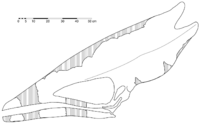Thalassodromeus facts for kids
Quick facts for kids ThalassodromeusTemporal range: Lower Cretaceous
|
|
|---|---|
 |
|
| Conservation status | |
|
Fossil
|
|
| Scientific classification | |
| Kingdom: | |
| Phylum: | |
| Class: | |
| Order: | |
| Suborder: | |
| Family: |
Tupuxuaridae
|
| Genus: |
Thalassodromeus
|
| Binomial name | |
| Thalassodromeus sethi Kellner & Campos, 2002
|
|
Imagine a flying reptile with a giant crest on its head! That's Thalassodromeus (say: Tha-lass-oh-DRO-mee-us), an amazing pterosaur that lived a long, long time ago. Its name means "sea runner," even though it flew in the sky! Scientists found its fossils in northern Brazil. This ancient flyer was about 60 centimeters long, and its wings could stretch out to 1 metre wide. The most striking thing about it was the huge, thin crest on its skull.
Contents
What Was Thalassodromeus?
Thalassodromeus sethi was a type of pterosaur, which were flying reptiles that lived during the time of the dinosaurs. It belonged to a group called Tupuxuaridae. These creatures were not dinosaurs themselves, but they lived alongside them. Thalassodromeus lived during the Lower Cretaceous period, which was about 110 million years ago.
The Amazing Head Crest
The most famous feature of Thalassodromeus was its enormous head crest. This crest was very thin and went from the tip of its snout all the way to the back of its head. It was so big that it was taller than the rest of its skull!
Scientists think this crest might have been used for a few things:
- Showing off: Maybe it helped Thalassodromeus attract a mate, like a peacock's tail.
- Controlling body temperature: The crest had many blood vessels. It might have helped the animal cool down or warm up.
- Steering in flight: Some experts believe it could have helped the pterosaur steer or balance while flying.
The name T. sethi was chosen because its crest looked a bit like the crown of the Egyptian god Seth. However, the crest actually looks more like the crown worn by another Egyptian god, Amun.
How Big Was This Flying Reptile?
Thalassodromeus was not the biggest pterosaur, but it was still quite impressive. It had a wingspan of about 1 meter (around 3.3 feet). This is similar to the wingspan of a large modern-day bird like an albatross. Its body was about 60 centimeters (2 feet) long.
What Did Thalassodromeus Eat?
Scientists have different ideas about what Thalassodromeus ate. Its jaws were long and pointed downwards.
The Skimming Theory
Originally, some scientists thought Thalassodromeus might have eaten like modern-day skimmer birds. Skimmers fly low over the water, dragging their lower beak in the water to catch fish. However, this idea has been questioned. The jaws of Thalassodromeus were very strong and thick, unlike the delicate jaws of skimmers. If it tried to skim, its jaw might have broken.
Other Food Ideas
Because of its strong jaws, other scientists think Thalassodromeus might have eaten different things. It could have been a hunter of small land animals, or perhaps it ate fruits and seeds. Its strong beak might have been good for crushing tough food.
Where Did Thalassodromeus Live?
The only fossils of Thalassodromeus have been found in the Santana Formation in northern Brazil. This area was likely a coastal region with lagoons and marshes during the Cretaceous period. This means Thalassodromeus probably lived near water, even if it didn't skim for fish.
Images for kids
-
Cast of the T. sethi holotype skull, Cleveland Museum of Natural History
-
Reconstructed skeleton of the related genus Tupuxuara in the American Museum of Natural History
-
The crest of T. sethi has been compared to a toucan's bill.
-
Comparison of the jaw of a skimmer (a–b), Tupuxuara (c), and the jaw tip of T. oberlii (or Banguela, d), with cross-sections at right
-
Restoration of T. sethi wading in a marsh
See also
 In Spanish: Thalassodromeus para niños
In Spanish: Thalassodromeus para niños











